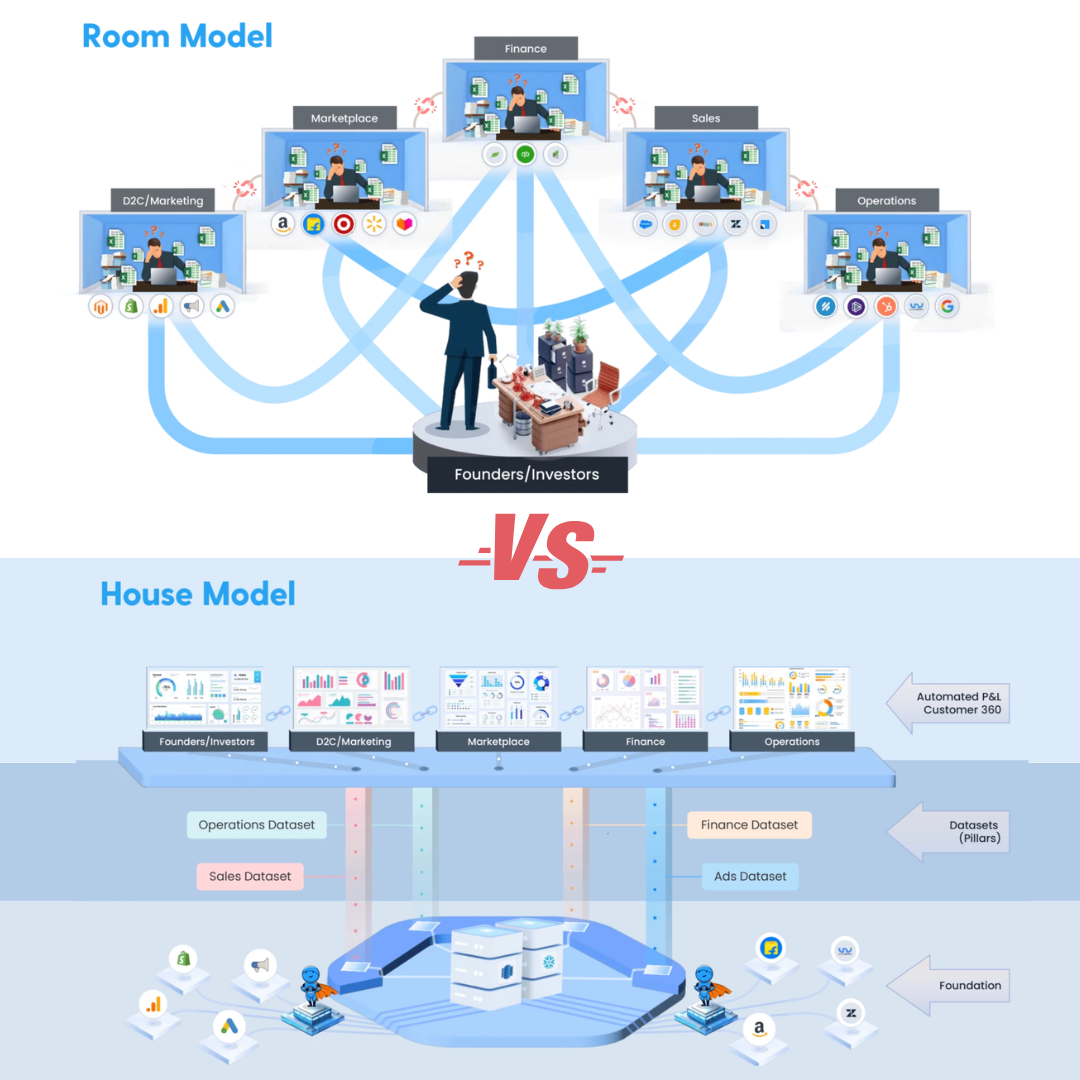Room vs House: Which data model suits your brand?

Balaji
Co-Founder
Digital brands with well established product market fit often scale rapidly due to lower cost structures, availability of funds, and the ability to reach a global audience by leveraging digital marketing channels.

Unfortunately, in this pursuit of hyper-growth, most brands miss to pay more attention in putting together data systems to scale further and build a robust data-driven culture.
In this article, I would like to compare setting up a data function with an analogy of renting a room vs. building a house and discuss the pros and cons of each model.
Room Model
In a rooms model, each business team (marketing, marketplaces, finance, and supply chain) lives in their own rooms (read silos), make their own decisions on tools, and have their own definitions of different business metrics like revenue, CLV, CAC, profits, etc. Business teams use point solutions available to support running their business functions. For example,
- Google Analytics, Triple Whale, or North Beam for attribution
- Lifetimely, Daasity, Glew for eCommerce reporting
- Seller Board, or Merchant Spring for managing their marketplace reporting
There may be 1 or 2 room maintenance staff (read analysts) supporting all data needs of the organization. These analysts are often the first hire in data teams and are usually spread thin across different requirements. Learn about the cons of a one-person data team.

Benefits & Challenges of Room Model
Benefits
- The hotel model gives autonomy to teams and can be very efficient if founders are hands-on with marketing, operations, and finance.
- Decision-making is faster and is vital in the early stage (<5M)
- Most of the point tools are cost-effective in the initial scale (5M)
Challenges
- Multiple sources of truth affect overall data quality, leading to limited data governance and misalignments between teams.
- Point solutions do not help with the deep financial and customer insights necessary for brands to become investor ready.
- Point solutions are often not customizable to specific business use cases and do not cater to all required use cases. It leads to uncatered data needs as the scale of the business grows.
- Founders, Investors, and CFOs who are not well-versed with the above tools and have limited bandwidth are usually dependent on individual teams for reporting and insights.
- The frequency of comprehensive reporting is monthly at best and quarterly at worst
- Blending data between different systems/sources is extremely limited, affecting team collaboration.
- Any new data or report request takes a disproportionate amount of time to create and maintain
- Setting organizational objectives and aligning all the teams on a standard measurement framework is challenging.
- Hiring experienced professionals in different functions can be challenging as they expect data systems to already be in place to work.
House Model
In the house model, a central data team is set up to build the data function from the ground up.
- Every house has a foundation, which in the data parlance is equivalent to consolidating data across all sources into a data warehouse.
- Cloud data warehouses like BigQuery or Snowflake can be set up in 15 minutes and are serverless, cost-effective, and easy to manage.
- No-code data pipelines like Daton make aggregating data in a data warehouse easy.
- Pillars in the house model are equivalent to modeled datasets in data stacks.
- Shopify, Amazon, and Walmart sales across countries can be unified into a single sales data set.
- Similarly, ads, customers, and finance can be unified into datasets for reporting and analysis.
- Dashboards and reports are equivalent to different rooms and interior elements of the house.
- Executives and Investors can have a central dashboard with access to every other team’s numbers.
- Each Individual team has its own room, which is customizable and accessible to other teams.
- As the foundation has all the data and pillars organized, building new dashboards and reports or rooms should be faster.

Benefits & Challenges of House Model
Benefits
- Single pane of view for all business teams (executive, finance, growth, product, and operations) to interact with and align on
- Become investor ready by understanding profitability across different sales channels and customer profitability through cohorts in the D2C channel.
- Stitch customer touchpoints across Ads, Analytics, Orders, Customer support, reviews, and surveys to create a unified customer profile
- Use the raw events data from GA4 to create a custom multi-touch attribution model.
- Blending data across is seamless, and model datasets should cover more than 80% of standard dimensions and metrics out of the box.
Challenges
- Building a data team requires a specialized team of analytics engineers, data engineers, BI developers, and data scientists who are difficult to hire and expensive in the market.
- Most brands end up hiring one or two analysts and expect them to perform all the roles leading to failed projects (Read more on Unicorn Analysts).
- Any churn in the data team can mean loss of tribal knowledge leading to a black box for new resources who replace them.
When should a brand move towards a House model?
I believe any brand with a revenue visibility of $10M ARR should invest in a house model, and the rationale is that every brand should budget 1% of its revenues in the data function. This 1% investment in optimizing their advertising strategies, becoming investor ready, and understanding the voice of their customer better more than pays for the investment.
Are you tired of renting rooms and are considering shifting to a data house? Schedule a call with me, and I’ll be happy to showcase how we have helped hundreds of retail, eCommerce, and DTC brands accelerate their data journey!




